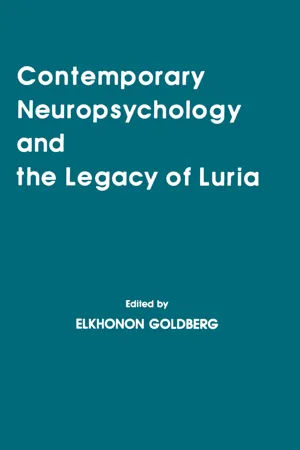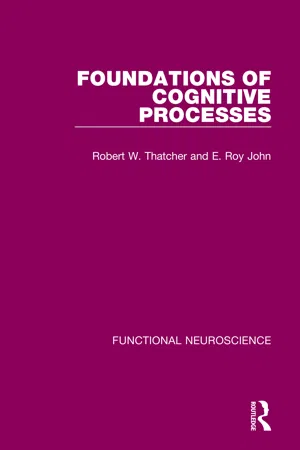Psychology
Localisation of Brain Function
The concept of "localisation of brain function" refers to the idea that specific mental functions are associated with particular areas of the brain. This concept suggests that different regions of the brain are responsible for different psychological processes, such as language, memory, and emotion. Research in this area has provided valuable insights into understanding how the brain supports various cognitive and emotional functions.
Written by Perlego with AI-assistance
Related key terms
Related key terms
1 of 4
Related key terms
1 of 3
5 Key excerpts on "Localisation of Brain Function"
- eBook - ePub
Cognitive Science
Contributions to Educational Practice
- Marlin L. Languis, James Buffer, Daniel Martin, Paul Naour(Authors)
- 2012(Publication Date)
- Routledge(Publisher)
Concepts about the relationship between brain and behavior have historically fallen into one of two diametrically opposed perspectives. The “localizers” represented by the tradition of Broca (1861) and others (Penfield & Boldrey, 1937; Benson & Geschwind, 1971) have conceived of behavioral localization as a mosaic of foci in the brain, with each foci representing discretely localized functions. This view was based on clinical-pathological correlations in which an important contribution to normal function is inferred from loss of behavior in pathological states (Wernicke, 1908) as well as the behavioral manifestations following electrical stimulation of intact tissue (Penfield & Boldrey). This idea of behavior as distributed in a “map” or “mosaic” fashion across the cortex has been a very powerful concept and has led to a basic understanding of the organization of language and motor-sensory function.The second concept of behavioral localization, termed “mass action”, was promoted by Lashley (1929). This concept emphasizes the behavioral importance of the amount of brain tissue lost. That is, the behavioral manifestations depend less on where tissue is lost in the brain than on how much tissue is lost. Chapman and Wolfe (1959) demonstrated that the deficits in cognition following neurosurgery correlated with the amount rather than the specific locus of brain tissue surgically removed. This is a powerful concept in brain injury that explains such clinical phenomena as the recovery from behavioral symptoms. In addition, this theory of mass action is more consistent with what we know about behavioral plasticity in the brain and recovery of function than the strict localizationist theory.Neither of these theories, however, has been able to explain the relationship between brain injury and emotional state. Localization of MoodNumerous investigators have studied relative hemispheric involvement in mood using brain-injured patients, intracarotid amytal injections, or unilateral visual or auditory input in nonbrain-injured volunteers. In a previous publication, we extensively reviewed this literature (Pearlson & Robinson, 1981). In general, these studies have commonly reported right-left hemisphere asymmetries in the production or expression of mood. For example, Gainotti (1972, 1979) has reported that right hemisphere brain injury is associated with indifference and a tendency to joke and minimize difficulties. Amytal studies have generally reported depressive reactions associated with left hemisphere inactivation and euphoria associated with right hemisphere inactivation (Terzian, 1964; Rossi & Rosandini, 1967). Likewise, tachistoscopic unilateral visual field stimulation and dichotic listening studies have reported negative emotion associated with right hemispheric stimulation and positive emotion following left hemisphere stimulation (Dimond, Farrington, & Johnson, 1976; Safer & Leventhal, 1977). Although there are numerous theories ranging from differential activation in the two hemispheres to each hemisphere producing a different mood (Tucker, 1981; Sackheim et al. - Elkhonon Goldberg(Author)
- 2019(Publication Date)
- Psychology Press(Publisher)
It is noteworthy that formulations of functional localization within the brain, as well as the opposing view of the brain as a diffusely organized equipotential structure, were mainly concerned with spatial issues. At no time during the 19th, or the first half of the 20th century did concepts of functional localization within the brain intersect with Donders's idea of mental chronometry. The virtual absence of temporal factors in neuropsychological theories is remarkable. Almost alone, von Monakov (1911) called attention to the "chronological localization of function" within the brain. But as with Donders, neither the conceptual atmosphere nor the necessary physiological techniques were available to support empirical studies of the temporal aspects of brain function.Some neuropsychological formulations appear to equate the localized processing carried out within a particular cortical structure with a processing stage, for example, visual word recognition. However, Luria (1973) pointed out that psychological processes should not be considered the function of a circumscribed tissue, but rather of an extended system, each part of which carries out various aspects of the process under consideration. This formulation clearly implies a temporal sequence of brain activation, in which a number of more or less localized brain areas carry out specific operations that are linked dynamically within the overall psychological process. If methods were available to observe the moment-to-moment activity within the brain, these dynamic patterns of local activation could be visualized. Indeed, evidence obtained by modern techniques for measuring local metabolic changes associated with neural activity, such as regional blood flow and positron emission tomography, have conclusively demonstrated the correctness of cortical localization, not only of sensorimotor processes, but of complex linguistic and cognitive activity (e.g., Lassen, Roland, Larsen, Melued. & Soh, 1977; Mazziota, Phelps, Carson, & Kuhl, 1982). Thus, during speech or reading, for example, multiple cortical areas increase their metabolic activity in the course of these mental and behavioral processes. The location of these circumscribed regions conforms quite well with the conventional cortical localization schemata derived from clinical observations on the impact of focal brain lesions.- eBook - ePub
- Robert W. Thatcher, E. Roy John(Authors)
- 2021(Publication Date)
- Routledge(Publisher)
In addition to experimental results, clinical observations provided support for antilocalization ideas. The distinguished neurologist Hughlings Jackson formulated a series of principles in sharp opposition to the idea of narrow localization (1869). Jackson stated that lesions of circumscribed brain areas seldom lead to complete loss of function. While voluntary movements or speech are often blocked, involuntary movements and utterances frequently remain. Jackson argued against the concept of function as mediated by narrowly circumscribed groups of cells in favor of a complex vertical organization with multiple representation at low brain stem levels, middle motor and sensory cortical levels, and high frontal cortex levels. Thus the localization of the cause of a symptom that is the reason for impairment of some function accompanying local lesion could not in any way be interpreted as evidence for localization of that particular function.At about the same time, other neurologists suggested that speech should be considered as a symbolic function disturbed by any complex damage to the brain. The so-called Noetic School of neurology held that the principal form of mental process was symbolic, and all brain damage caused depression of symbolic function (e.g., Goldstein, 1948). While accepting the cerebral localization of neurological symptoms, sensations, and elementary processes, Monakow and Mourgue (1928) argued against the localization of symbolic activity in any particular brain region. Head (1926) ascribed speech disturbances to lesions of large areas of cortex and attributed these disturbances to the loss of “vigilance.” Goldstein (1948) distinguished between the “periphery” of cortex, in which localized lesions disturb the means of mental activity (elementary functions), and the “central part,” treated as equipotential, in which lesions cause change in abstract behavior (higher functions) in accordance with the law of mass action. The ideas of this worker combine the principles of narrow localization with those of equipotentiality.Asratyan (1965) has reviewed the recovery of functions disturbed by ablations in various parts of the central nervous system. He describes two views about such phenomena: (1) the readjustment of behavior which takes place is due to the plasticity of an equipotential system; and (2) the recovery of functions which is observed is due to the stepwise relearning and compensation carried out by various parts of the nervous system, and is not due to the substitution of function.III. The Search for the Engram
- eBook - ePub
- Michael Cole(Author)
- 2017(Publication Date)
- Routledge(Publisher)
Vygotsky's ideas radically altered our view of the nature and structure of mental processes. Fixed and immutable "mental functions" were transformed into complex and mobile functional systems that change during development; psychology emerged from its constricting naturalistic boundaries and became the science of the social formation of natural phenomena.One question, however – perhaps the most essential one –remained open: How is the material substratum to be understood? What conceptions of the working of the brain should underlie our view of the material bases of mental activity?The problem of localizing mental functions in the cerebral hemispheres (and the question of the cerebral bases of mental activity was formulated in precisely this way) underwent a period of acute crisis in the 1920s, reflecting to a large extent the general crisis in psychology. On the one hand, neurology continued to assert its naive ideas of the localization of complex mental functions in limited areas of the cerebral cortex – ideas originally crystallized in the great discoveries of the 1870s. On the basis of the simplified views of mental functions then current in psychology, neurologists assumed that in addition to the cortical sensory and motor "centers," analogous centers could be found for more complex mental processes. As a result of the writings of Lissauer, Henschen, and Kleist, the idea of "perceptual centers," "calculational centers," and "conceptual centers" in the cerebral cortex did not seem the least bit extraordinary.Naturally enough, however, these views of restricted localization gave rise to serious doubt. Aware of the complexity of human higher mental processes and taking into account the well-known clinical fact that they could be disrupted by injuries in widely varied locations, many neurologists assumed that complex forms of mental processes were the result of the activity of the brain as a whole. Some of these authors, adhering to the holistic viewpoint (Monakov, Grunbaum), under the noticeable influence of the Würzburg school of psychology, were indifferent to all attempts to examine more closely the cerebral apparatuses connected with higher forms of mental activity. Others, supporting Gestalt psychology (K. Goldstein), tried to construct a hypothesis of an excitation structure evenly distributed throughout the cortex and to see the basis of complex forms of human mental activity in these featureless "structural" processes. While accepting a restricted localization of elementary physiological processes in limited areas of the cortex, they rejected in practice all concrete analysis of the critical zones that take part in the execution of complex forms of human mental activity. "Revolving in a vicious circle of structural psychology," wrote Vygotsky, "examination of the localization of specifically human functions vacillates between the poles of extreme naturalism and extreme spiritualism" (loc. cit. P. 386). - eBook - ePub
Connectionist Psychology
A Textbook with Readings
- Rob Ellis, G.W. Humphreys(Authors)
- 2020(Publication Date)
- Psychology Press(Publisher)
Abstract : When cognitive neuropsychologists make inferences about the functional architecture of the normal mind from selective cognitive impairments they generally assume that the effects of brain damage are local, that is, that the nondamaged components of the architecture continue to function as they did before the damage. This assumption follows from the view that the components of the functional architecture are modular, in the sense of being informationally encapsulated. In this target article it is argued that this “locality” assumption is probably not correct in general. Inferences about the functional architecture can nevertheless be made from neuropsychological data with an alternative set of assumptions, according to which human information processing is graded, distributed, and interactive. These claims are supported by three examples of neuropsychological dissociations and a comparison of the inferences obtained from these impairments with and without the locality assumptions. The three dissociations are: selective impairments in knowledge of living things, disengagment of visual attention, and overt face recognition. In all three cases, the neuropsychological phenomena lead to more plausible inferences about the normal functional architecture when the locality assumption is abandoned. Also discussed are the relations between the locality assumption in neuropsychology and broader issues, including Fodor’s modularity hypothesis and the choice between top-down and bottom-up research approaches.Keywords : brain lesions, cognitive architecture, face recognition, localization, modularity, neural nets, neuropsychology, semantics, visionThe fact that the various parts of the en-cephalon, though anatomically distinct, are yet so intimately combined and related as to form a complex whole, makes it natural to suppose that lesions of greater or lesser extent in any one part should produce such general perturbation of the functions of the organ as a whole as to render it at least highly difficult to trace any uncomplicated connection between the symptoms produced and the lesion as such. Ferner (1886) .1. Introduction
Brain damage often has rather selective effects on cognitive functioning, impairing some abilities while sparing others. Psychologists interested in describing the “functional architecture” of the mind, that is, the set of relatively independent information-processing subsystems that underlies human intelligence, have recognized that patterns of cognitive deficit and sparing after brain damage are a potentially useful source of constraints on the functional architecture. In this target article I wish to focus on one of the assumptions that frequently underlies the use of neuropsychological data in the development of cognitive theories.
Index pages curate the most relevant extracts from our library of academic textbooks. They’ve been created using an in-house natural language model (NLM), each adding context and meaning to key research topics.
Explore more topic indexes
Explore more topic indexes
1 of 6
Explore more topic indexes
1 of 4




